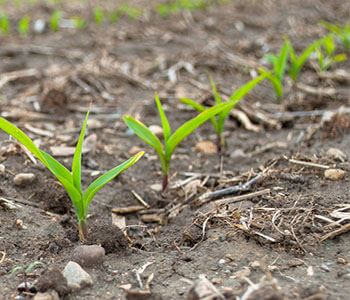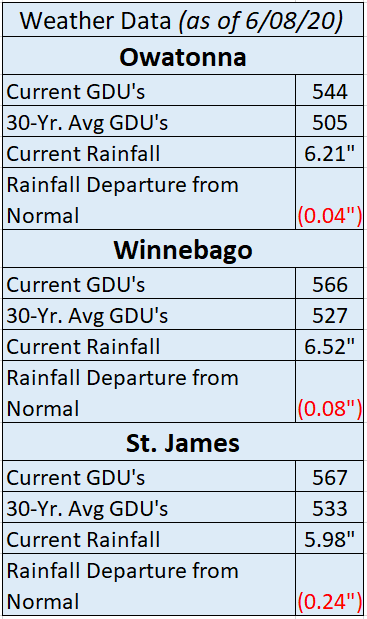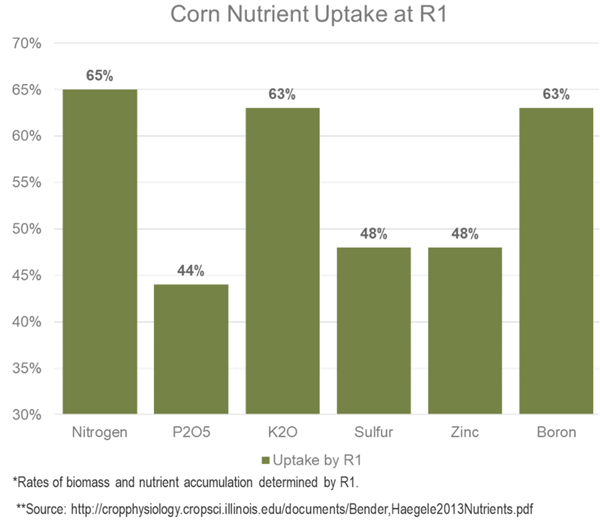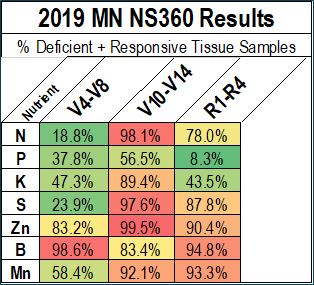2020.06.11 - Growing Insights
Jun 11, 2020

 |
|
|---|
| Sulfur Strategy | |
|---|---|
|
Before too many weeks pass, we will start to see corn with visible tassels, marking a critical change from corn growth with focus on vegetative development to reproductive development. This also marks a key time when only a portion of the total nutrient uptake has occurred at R1 (silking). Data from the University of Illinois Crop Sciences department research, below, show that more than 1/3 to ½ of nutrient uptake will take place after VT. |
|
|
|
 |
|---|
|
98% of N, 20% of potassium, 95% of sulfur, 65% of boron and 30% of zinc are taken up via mass flow. For successful uptake to occur, nutrients will have to be available in the rooting zone and with sufficient moisture levels. 91% of phosphorus, 78% of potassium, 32% boron and 40% of zinc are taken up by diffusion, requiring a higher concentration of these nutrients in the root zone. The success at the end of the year will be influenced by how large of a profile roots today can explore, the photosynthesis captured, moisture available, and how well we managed our 2020 corn nutrient plan to have the fertility available when the corn crop needed it the most.  The ratio between nitrogen (N) and sulfur (S) is important to measure and understand the impact it has on nitrogen use efficiency, plant vigor, water use efficiency, phosphate use, carbohydrate production and utilization, rate of grain fill, maturity and many other plant factors. The N:S ratio primarily reflects the complementary relationship that N and S have in producing plant proteins. Proteins are the building blocks of enzymes and enzymes either increase or decrease a chemical reaction in a plant. The production and accumulation of starches in the seed are impacted by enzyme production. Therefore, the rate of grain fill and maturity will be impacted by the production of proteins. Converting phosphorus to the plant energy system is directly controlled by enzymatic activity, thus protein production and activity. A tissue sample that shows a N:S ratio of 15:1 is the goal. A portion of the sulfur is released from organic matter. Organic sulfur must be mineralized to sulfate sulfur. Soil temperature and moisture largely determine when and how much of the organic form of sulfur is made available to the crop. Cold and excessively wet or dry conditions reduce microbial activity and reduce S availability from soil organic matter and crop residues. At most, only a few percent of the organic sulfur is made available to the crop annually. Many people utilize a fall-applied sulfur option in elemental sulfur, that is initially immobile. For elemental sulfur to become available to a growing crop, it must be broken down into sulfate by soil microbes. Microbes need warm, moist soils with adequate aeration to work, and the oxidation process of elemental sulfur makes sulfur slowly available over time. Elemental sulfur helps complement the use of in-season applications of sulfur by providing a stream of available sulfur over extended amounts of time. If you are going to sidedress/topdress N, don’t forget about sulfur! Use a tissue sample to help indicate S levels using N:S ratios! We need to keep S in the root zone later in the year with N, so be sure to talk to your local CFS representative to understand potential in-season options to add sulfur to your corn. |
|---|
